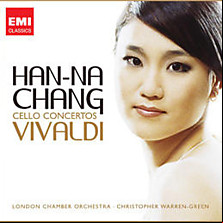BBC Review 1bj6o
A performance oozing soul and individuality.
Charlotte Gardner 2008
Vivaldi, for Han-Na Chang, represents the ''liveliness of harmony and rhythm. …It is in the colours and forms that he creates''. This disc of Vivaldi's cello concertos is Chang's first foray into recording Baroque repertoire, and she plays with all the intensity that it is a characteristic of her recordings of nineteenth and twentieth century music.
Vivaldi's cello concertos date from the early 1700s through to the late 1730s. The recipients were the female orphans of the Ospedale della Pieta where he taught the violin and directed the orchestra, as well as for colleagues and patrons. The cello was very much in its early days as a solo instrument, more accustomed to providing the bass line than to taking centre stage; this might explain why none of these concertos were published in Vivaldi's lifetime, surviving only in manuscript form. Vivaldi clearly spotted the instrument's massive solo potential though; you don't write thirty concertos for an instrument you've written off as a dud, even if you do have an orphanage of girls clamouring for music. In these works, you hear him exploring the cellos emotional range to the full, for instance in the E flat major concerto RV408, where a deeply sorrowful middle-movement Largo is forgotten in the spirited brightness of the final movement's Allegro. The possibilities inherent in the soloist/tutti relationship are also explored over the years, progressing from the soloist's light continuo accompaniment in earlier concertos, to its greater dialogue with the orchestra in the later works. One thing Vivaldi didn't explore as much were the cello's different s; the tessitura of these concertos is mostly low.
Han-Na Chang was a pupil of Rostropovich, and his influence is apparent in her expressive powers, her warm tone, and in her playing's occasional sense of abandon, kept in check by a strong sense of rhythmic discipline. These qualities have the effect of making Vivaldi's music often feel more Romantic (note the capital letter there, I don't mean mushy) than Baroque in style, but I don't say that as a criticism; this is a performance oozing soul and individuality.

